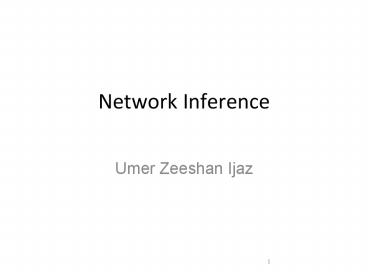Network Inference PowerPoint PPT Presentation
Title: Network Inference
1
Network Inference
- Umer Zeeshan Ijaz
1
2
Overview
- Introduction
- Application Areas
- cDNA Microarray
- EEG/ECoG
- Network Inference
- Pair-wise Similarity Measures
- Cross-correlation
STATIC - Coherence
STATIC - Autoregressive
- Granger Causality
STATIC - Probabilistic Graphical Models
- Directed
- Kalman-filtering based EM algorithm
STATIC - Undirected
- Kernel-weighted logistic regression method
DYNAMIC - Graphical Lasso-model
STATIC
3
Introduction
4
cDNA Microarray
5
EoCG/EEG
6
Cross-correlation based(1)
For a pair of time series xit and xjt of
lengths n, the sample correlation at lag t
Measure of Coupling is the maximum cross
correlation
Use P-Value test to compare zij with a standard
normal distribution with mean zero and variance 1
7
Cross-correlation based (2)
Significance test ANALYTIC METHOD
Use Fisher Transformation the resulting
distribution is normal and has the standard
deviation of
Use scaled value that is expected to behave like
the maximum of the absolute value of a sequence
of random numbers. Using now established results
for statistics of this form, we obtain therefore
that
M. A. Kramer, U. T. Eden, S. S. Cash, E. D.
Kolaczyk, Network inference with confidence from
multivariate time series. Physical review E 79,
061916, 2009
8
Cross-correlation based (3)
Significance test FREQUENCY DOMAIN BOOTSTRAP
METHOD
- Compute the power spectrum (Hanning tapered) of
each series and average these power spectra
from all the time series - Compute the standardized and whitened residuals
for each time series - For each bootstrap replicate, RESAMPLE
WITH REPLACEMENT and compute the surrogate data - Compute such instances and calculate
maximum cross-correlation for each pair of
nodes i and j - Finally compare the bootstrap distribution and
assign a p-value
9
Cross-correlation based (4)
False Detection Rate Test
- Order mN(N-1)/2 p-values
- Choose FDR level q
- Compare each to critical value
and find the maximum i such that - We reject the null hypothesis that time series
and are uncoupled for
M. A. Kramer, U. T. Eden, S. S. Cash, and E. D.
Kolaczyk. Network inference with confidence from
multivariate time series, Physics Review E
79(061916), 1-13, 2009
10
Coherence based
Coherence Signals are fully correlated with
constant phase shifts, although they may show
difference in amplitude
Cross-phase spectrum Provides information on
time-relationships between two signals as a
function of frequency. Phase displacement may be
converted into time displacement
11
Coherence based(2)
S. Weiss, and H. M. Mueller. The contribution of
EEG coherence to the investigation of language,
Brain and Language 85(2), 325-343, 2003
12
Granger Causality
Directed Transfer Function Directional
influences between any given pair of channels in
a multivariate data set
Bivariate autoregressive process
If the variance of the prediction error is
reduced by the inclusion of other series, then
based on granger causality, one depends on
another. Now taking the fourier transform
Granger causality from channel j to i
13
Kalman Filter
- State Space Model (State Variable Model
State Evolution Model)
State Equation
Measurement Equation
Measurement Update(Filtering)
Time Update(Prediction)
14
Probabilistic graphical models(1)
Joint distribution over a set
Bayesian Networks associate with each variable
a conditional probability
The resulting product is of the form
A
B
P(CA,B) A B 0 1 0 0 0.9 0.1 0 1 0.2 0.8 1 0
0.9 0.1 1 1 0.01 0.99
C
D
E
15
EM Algorithm Predicting gene regulatory network
Constructing the network
16
EM Algorithm Predicting gene regulatory
network(2)
Conditional distribution of state and observables
Factorization rule for bayesian network
Unknowns in the system
17
EM Algorithm Predicting gene regulatory
network(4)
Construct the likelihood
Construct the likelihood
Marginalize with respect to x and introducing a
distribution Q
18
Kalman filter based Inferring network from
microarray expression data(5)
Lets say we want to compute C
19
Kalman filter based Inferring network from
microarray expression data(9)
Experimental Results A standard T-Cell
activation model
Claudia Rangel, John Angus, Zoubin Ghahramani,
Maria Lioumi, Elizabeth Sotheran, Alessia Gaiba,
David L. Wild, Francesco Falciani Modeling
T-cell activation using gene expression profiling
and state-space models. Bioinformatics 20(9)
1361-1372 (2004)
20
Probabilistic graphical models(2)
Markov Networks represent joint distribution as a
product of potentials
D
A
A B p1(A,B) 0 0 1.0 0 1 0.5 1 0 0.5 1 1 2.0
B
C
E
21
Kernel-weighted logistic regression method(1)
Pair-wise Markov Random Field
x6
x7
??56
??57
x1
x8
x5
??25
??48
Logistic Function
??12
??54
x2
x4
??23
??34
x3
Log Likelihood
Optimization problem
22
Kernel-weighted logistic regression method(2)
23
Kernel-weighted logistic regression method(3)
Interaction between gene ontological groups
related to developmental process undergoing
dynamic rewiring. The weight of an edge between
two ontological groups is the total number of
connection between genes in the two groups. In
the visualization, the width of an edge is
propotional to the edge weight. The edge weight
is thresholded at 30 so that only those
interactions exceeding this number are displayed.
The average network on left is produced by
averaging the right side. In this case, the
threshold is set to 20
L. Song, M. Kolar, and E. P. Xing. KELLER
estimating time-varying interactions between
genes. Bioinformatics 25, i128-i136, 2009
24
Graphical Lasso Model(1)
O. Banerjee, L. E. Ghaoui, A. dAspremont. Model
selection through sparse maximum likelihood
estimation for multivariate gaussian or binary
data. Journal of Machine Language Research 101,
2007
25
Graphical Lasso Model(2)
Solve the lasso problem for w12 over jth column
one at a time
O. Banerjee, L. E. Ghaoui, A. dAspremont. Model
selection through sparse maximum likelihood
estimation for multivariate gaussian or binary
data. Journal of Machine Language Research 101,
2007
26
Graphical Lasso Model(3)
Software under development _at_ Oxford Complex
Systems Group
with Nick Jones Results shown for
Google Trend Dataset
27
THE END
27

